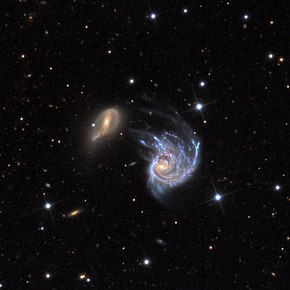| UGC 480 | |
|---|---|
 UGC 480 (right) interacting with PGC 2726 Credit: Adam Block/ Mount Lemmon SkyCenter/ University of Arizona | |
| Observation data ( J2000 epoch) | |
| Constellation | Andromeda |
| Right ascension | 00h 46m 32.0s [1] |
| Declination | +36° 19′ 32″ [1] |
| Redshift | 0.037426 [1] |
| Distance | ~500 Mly [2] |
| Apparent magnitude (V) | 13.50 [1] |
| Apparent magnitude (B) | 13.6 [3] |
| Characteristics | |
| Type | S [1] |
| Apparent size (V) | 1.5' × 1.2' [1] |
| Other designations | |
| UGC 480, UGC 480 W, CGCG 519-021, MCG +06-02-016, VV 527A, KPG 16A, 2MASX J00463200+3619318, 2MASXi J0046319+361932, IRAS 00438+3603, F00437+3603, PGC 2720. [1] | |
NGC 218, also known as UGC 480, is a spiral galaxy located approximately 500 million light-years from the Sun [2] in the constellation Andromeda. It was discovered on October 17, 1876 by Édouard Stephan, and is interacting with the galaxy PGC 2726. [4]
- ^ a b c d e f g "NASA/IPAC Extragalactic Database". Results for NGC 0218. Retrieved 2016-09-02.
- ^ a b An object's distance from Earth can be determined using Hubble's law: v=Ho is Hubble's constant (70±5 (km/s)/Mpc). The relative uncertainty Δd/d divided by the distance is equal to the sum of the relative uncertainties of the velocity and v=Ho
- ^ "UGC 480". SIMBAD. Centre de données astronomiques de Strasbourg. Retrieved 21 February 2017.
- ^ "New General Catalog Objects: NGC 200 - 249". Cseligman. Retrieved September 10, 2016.
-
 Media related to
NGC 218 at Wikimedia Commons
Media related to
NGC 218 at Wikimedia Commons - NGC 218 on WikiSky: DSS2, SDSS, GALEX, IRAS, Hydrogen α, X-Ray, Astrophoto, Sky Map, Articles and images
- SEDS
| UGC 480 | |
|---|---|
 UGC 480 (right) interacting with PGC 2726 Credit: Adam Block/ Mount Lemmon SkyCenter/ University of Arizona | |
| Observation data ( J2000 epoch) | |
| Constellation | Andromeda |
| Right ascension | 00h 46m 32.0s [1] |
| Declination | +36° 19′ 32″ [1] |
| Redshift | 0.037426 [1] |
| Distance | ~500 Mly [2] |
| Apparent magnitude (V) | 13.50 [1] |
| Apparent magnitude (B) | 13.6 [3] |
| Characteristics | |
| Type | S [1] |
| Apparent size (V) | 1.5' × 1.2' [1] |
| Other designations | |
| UGC 480, UGC 480 W, CGCG 519-021, MCG +06-02-016, VV 527A, KPG 16A, 2MASX J00463200+3619318, 2MASXi J0046319+361932, IRAS 00438+3603, F00437+3603, PGC 2720. [1] | |
NGC 218, also known as UGC 480, is a spiral galaxy located approximately 500 million light-years from the Sun [2] in the constellation Andromeda. It was discovered on October 17, 1876 by Édouard Stephan, and is interacting with the galaxy PGC 2726. [4]
- ^ a b c d e f g "NASA/IPAC Extragalactic Database". Results for NGC 0218. Retrieved 2016-09-02.
- ^ a b An object's distance from Earth can be determined using Hubble's law: v=Ho is Hubble's constant (70±5 (km/s)/Mpc). The relative uncertainty Δd/d divided by the distance is equal to the sum of the relative uncertainties of the velocity and v=Ho
- ^ "UGC 480". SIMBAD. Centre de données astronomiques de Strasbourg. Retrieved 21 February 2017.
- ^ "New General Catalog Objects: NGC 200 - 249". Cseligman. Retrieved September 10, 2016.
-
 Media related to
NGC 218 at Wikimedia Commons
Media related to
NGC 218 at Wikimedia Commons - NGC 218 on WikiSky: DSS2, SDSS, GALEX, IRAS, Hydrogen α, X-Ray, Astrophoto, Sky Map, Articles and images
- SEDS